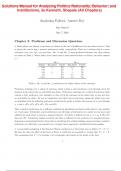Tentamen (uitwerkingen)
Solutions Manual for Analyzing Politics Rationality, Behavior, and Instititutions, 2nd Edition By Kenneth, Shepsle (All Chapters) Complete Guide A+
- Vak
- Instelling
- Boek
Solutions Manual for Analyzing Politics Rationality, Behavior, and Instititutions, 2nd Edition By Kenneth, Shepsle (All Chapters) Complete Guide A+
[Meer zien]














